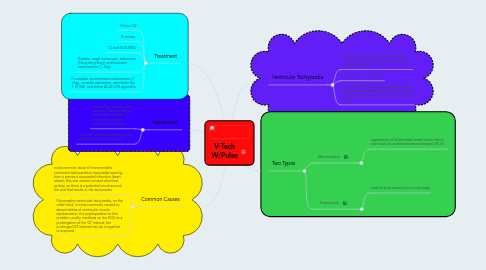V-Tach W/Pulse
作者:Travis Kimberling


1. Common Causes
1.1. most common cause of monomorphic ventricular tachycardia is myocardial scarring from a previous myocardial infarction (heart attack); this scar cannot conduct electrical activity, so there is a potential circuit around the scar that results in the tachycardia
1.2. Polymorphic ventricular tachycardia, on the other hand, is most commonly caused by abnormalities of ventricular muscle repolarization; the predisposition to this problem usually manifests on the ECG as a prolongation of the QT interval; the prolonged QT interval may be congenital or acquired
2. Assessment
2.1. patient may present with: dizziness, fainting, fatigue, chest pain, shortness of breath, hypotension, diminished perfusion,
2.2. In severe, unstable patients: severe hypotension, very tachycardic
3. Treatment
3.1. Hi-flow O2
3.2. IV access
3.3. 12 lead ECG/EKG
3.4. If stable: vegal maneuvers, adenosine (12mg-6mg-6mg), synchronized cardioversion (1 J/kg)
3.5. If unstable: synchronized cardioversion (1 J/kg), consider adenosine, administer Epi 1:10,000 and follow ACLS-CPR algorithm
4. Ventricular Tachycardia
4.1. rapid heart beat that arises from improper electrical activity of the heart presenting as a rapid heart rhythm
4.2. originates in the ventricles
4.3. potentially life-threatening arrhythmia because it can cause low blood pressure and may lead to ventricular fibrillation, asystole, and sudden death
5. Two Types
5.1. Monomorphic
5.1.1. appearance of all the beats match each other in each lead of a surface electrocardiogram (ECG).
5.2. Polymorphic
5.2.1. beat-to-beat variations in morphology
